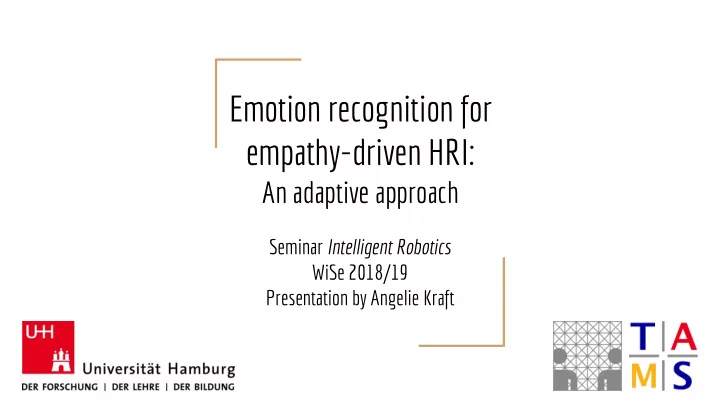

Emotion recognition for empathy-driven HRI: An adaptive approach Seminar Intelligent Robotics WiSe 2018/19 Presentation by Angelie Kraft
Overview I. Introduction II. An Empathy-Driven Approach by Churamani et al. (2018) III. Evaluation IV. Conclusion V. References 2
I. Introduction 1 Future Life with Pepper (2016) [https://www.youtube.com/watch?v=-A3ZLLGuvQY] 3 “Pepper” by Softbank Robotics https://spectrum.ieee.org/image/MjU4NjkzNA.jpeg 3
Why do we need robot companions? Understanding humans for better ● 1 service Emotion conveys intentions and needs ○ Positive psychological effects: ● 3 Autism, dementia, education ○ How does Pepper do it? ● Multi-modal emotion recognition! ○ NICO (Neuro-Inspired COmpanion) by Kerzel et al. (2017) https://www.inf.uni-hamburg.de/en/inst/ab/wtm/research/neurobotics/nico.html 4
II. An approach to empathy-driven HRI By Churamani, Barros, Strahl, & Wermter (2018) 5
Emotion perception module 1. Multi-Channel Convolutional NN (MCCNN): 1. Channel: Visual information ○ 2. Channel: Auditory information ○ → Learning ○ 2. Growing-When-Required (GWR) network: Account for variance in stimuli ○ → Adapting ○ 6 Churamani et al. (2018)
Learning with a Multi-Channel CNN Both layers trained equivalently ● Sound transformed into image data: ● Power spectrum intro “mel scale” ○ frequency 7 Churamani et al. (2018)
Multi-Channel CNN: Visual channel Two convolutional layers: ● Each filter learns different features ○ First layer: low-level features (e.g. ○ edges with different orientations) Second layer: abstract features (e.g. ○ eyes, mouth) 8 Churamani et al. (2018)
Multi-Channel CNN: Visual channel Shunting inhibition for robustness ● Max pooling for down-sampling ● Fully connected layer represents facial ● features for emotion classification 9 Churamani et al. (2018)
Combining both channels 10 Churamani et al. (2018)
https://veganuary.com/wp-content/uploads/2016/09/face http://hahasforhoohas.com/sites/hahasforhoohas.com -shocked-1511388.jpg /files/uploadimages/images/shocked-face-gif.png 11
Growing-When-Required Is activity of the best-matching neuron high enough? ● Yes: Keep ○ No: Create new node ○ Delete “outdated” edges & nodes ● → Represents emotions in clusters Churamani et al. (2018) 12 Marsland, Shapiro, & Nehmzow (2002)
Then what? Reinforcement GWR Learning 13 Churamani et al. (2018)
Emotion expression module 14 Churamani et al. (2018)
III. Evaluation - Accuracy: SAVEE Surrey Audio-Visual Expressed Emotions ● Standardized lab-recordings ● F: Face channel A: Speech & Music (Auditory Channel) AV: Face & Auditory Combined Accuracy in % 15 Barros & Wermter (2016)
Accuracy: EmotiW Emotion recognition “in the wild” ● More natural settings ● V: Face & Movement (Visual Channel) A: Speech & Music (Auditory Channel) AV: Visual & Auditory Combined Accuracy in % 16 Barros & Wermter (2016)
Comparison with other successful approaches EmotiW Mean accuracy (%) on validation split 17 Barros & Wermter (2016)
GWR vs. no GWR EmotiW Accuracy (%) on validation split Barros & Wermter (2017) 18
IV. Conclusion Empathy-driven HRI need should account for ... ● Multi-modality : e.g. Multi-Channel CNN ● Interindividual variability : e.g. Growing-When-Required ● Context : e.g. Affective Memory ● Shunting Inhibition for efficiency, robustness ● More channels for more multi-modality? ● What if user affect changes instantly? ● 19
V. References Barros, P., Weber, C., & Wermter, S. (2015). Emotional Expression Recognition with a Cross-Channel Convolutional Neural Network for Human-Robot Interaction. In IEEE-RAS 15th International Conference on Humanoid Robots (Humanoids) (pp. 582–587). Seoul, Korea: IEEE. Barros, P., & Wermter, S. (2016). Developing Crossmodal Expression Recognition Based on a Deep Neural mModel. Adaptive Behavior , 24 (5), 373–396. https://doi.org/10.1177/1059712316664017 Barros, P., & Wermter, S. (2017). A Self-Organizing Model for Affective Memory. In International Joint Conference on Neural Networks (IJCNN) (pp. 31–38). IEEE. Churamani, N., Barros, P., Strahl, E., & Wermter, S. (2018). Learning Empathy-Driven Emotion Expressions using Affective Modulations. In Proceedings of International Joint Conference on Neural Networks (IJCNN) . IEEE. https://doi.org/10.1109/IJCNN.2018.8489158 Marsland, S., Shapiro, J., & Nehmzow, U. (2002). A Self-Organising Network that Grows When Required. Neural Networks , 15 (8-9), 1041-1058. Matthias Kerzel, Erik Strahl, Sven Magg, Nicolás Navarro-Guerrero, Stefan Heinrich, Stefan Wermter. NICO – Neuro-Inspired COmpanion: A Developmental Humanoid Robot Platform for Multimodal Interaction. Proceedings of the IEEE International Symposium on Robot and Human Interactive Communication (RO-MAN) (pp. 113 - 120). Lisbon, Portugal. 2017. Mordoch, E., Osterreicher, A., Guse, L., Roger, K., & Thompson, G. (2013). Use of Social Commitment Robots in the Care of Elderly People with Dementia: A Literature Review. Maturitas , 74 (1), 14-20. 20
V. References Ricks, D. J., & Colton, M. B. (2010). Trends and Considerations in Robot-Assisted Autism Therapy. In Robotics and Automation (ICRA), 2010 IEEE International Conference on (pp. 4354-4359). IEEE. Tielman, M., Neerincx, M., Meyer, J. J., & Looije, R. (2014). Adaptive Emotional Expression in Robot-Child Interaction. In Proceedings of the 2014 ACM/IEEE international conference on Human-robot interaction (pp. 407-414). ACM. Tivive, F. H. C., & Bouzerdoum, A. (2006). A Shunting Inhibitory Convolutional Neural Network for Gender Classification. In 18th International Conference on Pattern Recognition 2006 (ICPR 2006) (Vol. 4, pp. 421–424). IEEE. 21
Excursus: Shunting inhibition Neuro-physiological plausible mechanisms present in several visual and cognitive functions ● Improve efficiency of filters when applied to complex cells: ● increase robustness to geometric distortion ○ learn more high-level features ○ Can reduce amount of layers needed ● less parameters to be trained ○ https://en.wikipedia.org/wiki/Distortion_(optics) Barros & Wermter (2016) 22
Excursus: Intrinsic Emotion 23
Thank you for listening! Any questions? 24
Recommend
More recommend